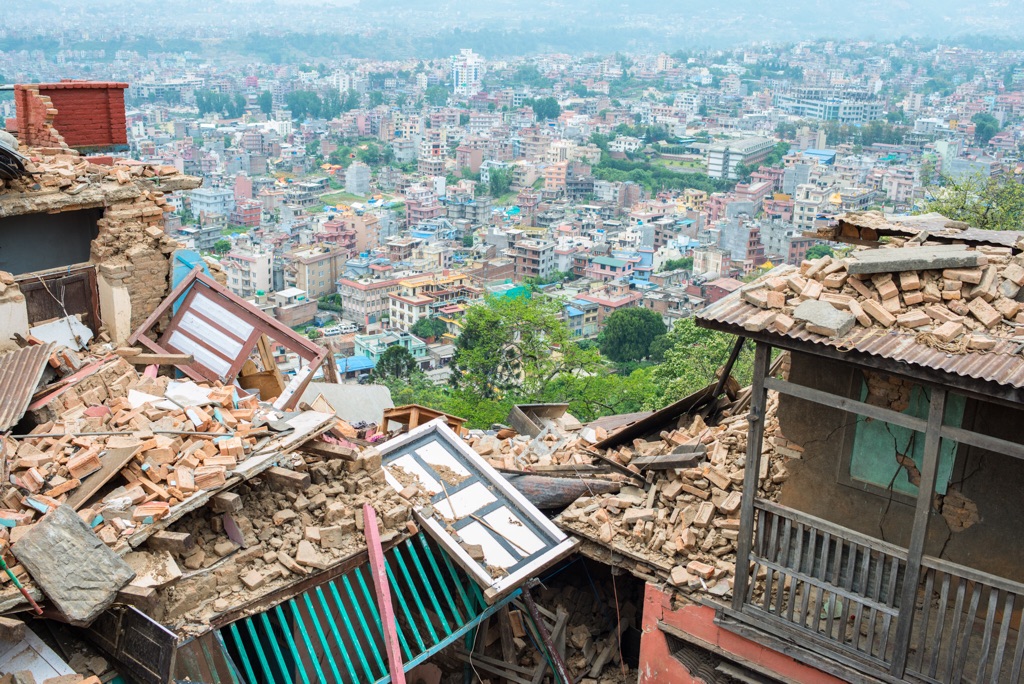My Earthquake Experience in Kathmandu sparked a decade of service. On April 25th, 2015, I was in Kathmandu, Nepal, with our head trekking guide, Dawa Sherpa, when the devastating 7.8 magnitude earthquake struck. We were sitting at the Nirvana Café near the iconic Swayambhunath Stupa, also known as the Monkey Temple—one of Kathmandu’s most sacred and historic sites. We had a week of work to do before we had a big groups arriving for their treks to Everest and Annapurna.
Moment Before the Earthquake
Just minutes before the quake, we had been talking about how a major earthquake in the region was overdue. We talked about starting a charity side to Ian Taylor Trekking to help the remote community where Dawa was from. The discussion led to financing projects and starting small businesses to support local people and the development of this non-profit. That experience in Kathmandu marked a turning point in my life and led to over a decade of community support and rebuilding efforts across Nepal.
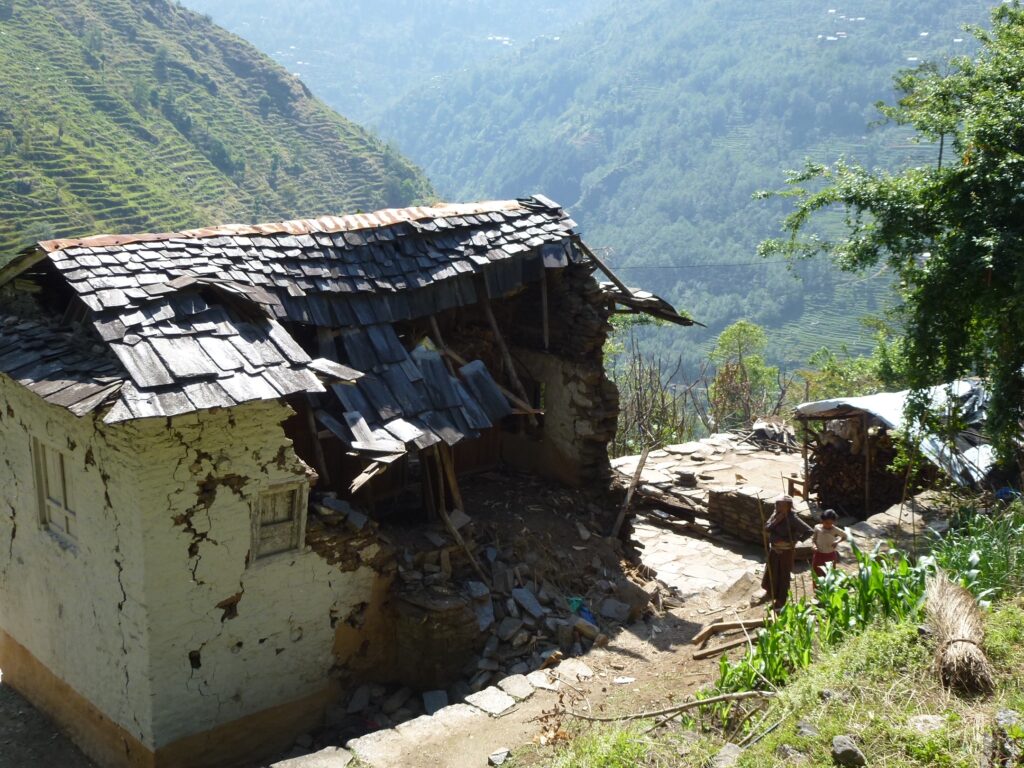
Tried After Three Weeks in the Mountains
That morning 25th April 2015, I couldn’t get out of bed. I had been leading groups to Everest Base Camp and Island Peak. It was nice to have a morning off after 3 busy weeks in the mountains. 9 am came and it was time to get up. I noticed Dawa was out watering his plants, so I went outside to join him. He had been up since 5am as he dropped our head climbing Sherpa, Ang Kami to the bus station.
Ang Kami was heading back to the village Goli where his wife and 3 year old baby lived. He was going for a week before he would head back to the Everest trail with us. Most of our staff come from the same village in the lower Khumbu region below Mount Everest. CLICK HERE to read article from the Irish Times.
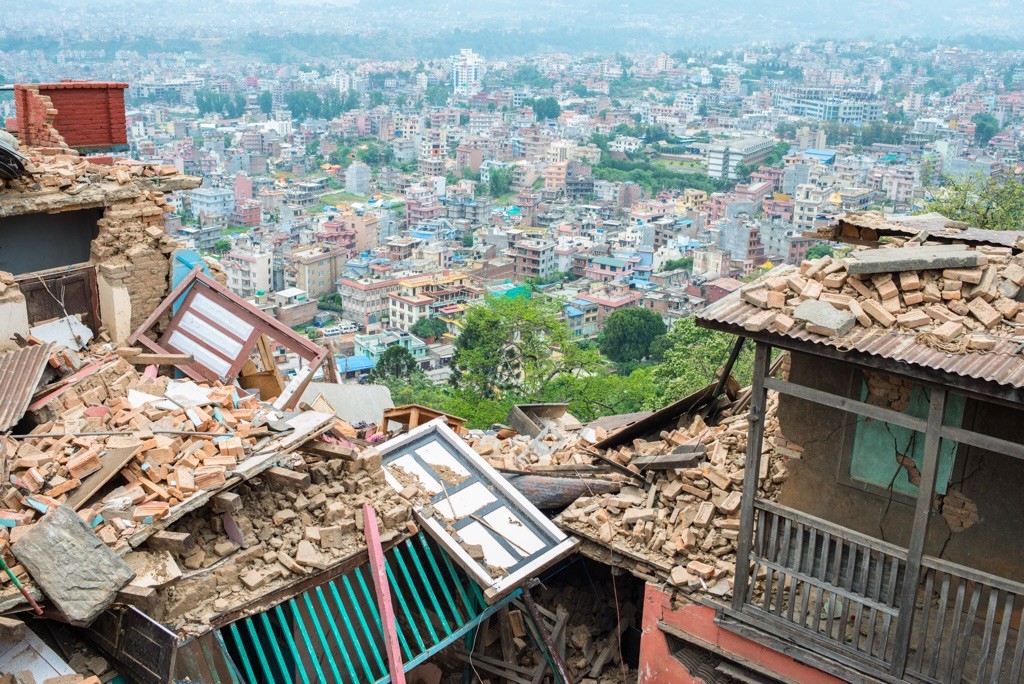
Moments Before the Earthquake in Kathmandu: A Morning at Swayambhunath
That morning, Dawa had made me a coffee and two boiled eggs, kindly offered me a shower, and I told him I’d take one later. He suggested we head out to grab another coffee at Swayambhunath—the famous Monkey Temple perched above Kathmandu. We hopped on his motorbike, rode through the narrow alleys, and made our way up to the ancient temple complex. It was just after 10 a.m. when we climbed the steep steps and began walking around the stupa, taking in the vibrant scene and the many smaller shrines dotting the hill.
I remember it being especially busy that morning. One moment that stood out was when someone’s jacket caught fire from one of the butter lamps, and Dawa immediately jumped into action to help. After walking the temple circuit, we passed through a narrow tunnel that led to the Nirvana Café, known for its decent coffee and panoramic views over the Kathmandu Valley.
As we sat there sipping our drinks, we talked about a range of things—including earthquakes in Nepal. Ironically, we discussed what we would do if one struck while guiding trekking groups in the Everest region. We even outlined a rough action plan to ensure safety in case of landslides or trail disruptions. Little did we know that within hours, our planning would be tested in the most profound way.

Near Miss at the Royal Palace in Kathmandu
After finishing our coffee at Swayambhunath, we headed back toward Thamel around 11:15 a.m. Dawa dropped me off at the hotel where our trekking group was staying, and he began gathering the rest of the team. My plan for the afternoon was to take some of the group to visit the royal palace and nearby Durbar Square—One of the most iconic heritage sites in Kathmandu.
But we were delayed. We waited in the hotel lobby for Paul, who was running a few minutes late. In hindsight, thank God he was. Had we left just five minutes earlier, we would likely have been walking through the narrow street in Thamel (the tourist district) when the earthquake struck. The buildings in that area crumbled in seconds.
When the 7.8 magnitude earthquake hit, every street surrounding our hotel in Thamel was suddenly inaccessible—completely blocked by fallen debris and collapsed buildings. That short delay may very well have saved our lives.
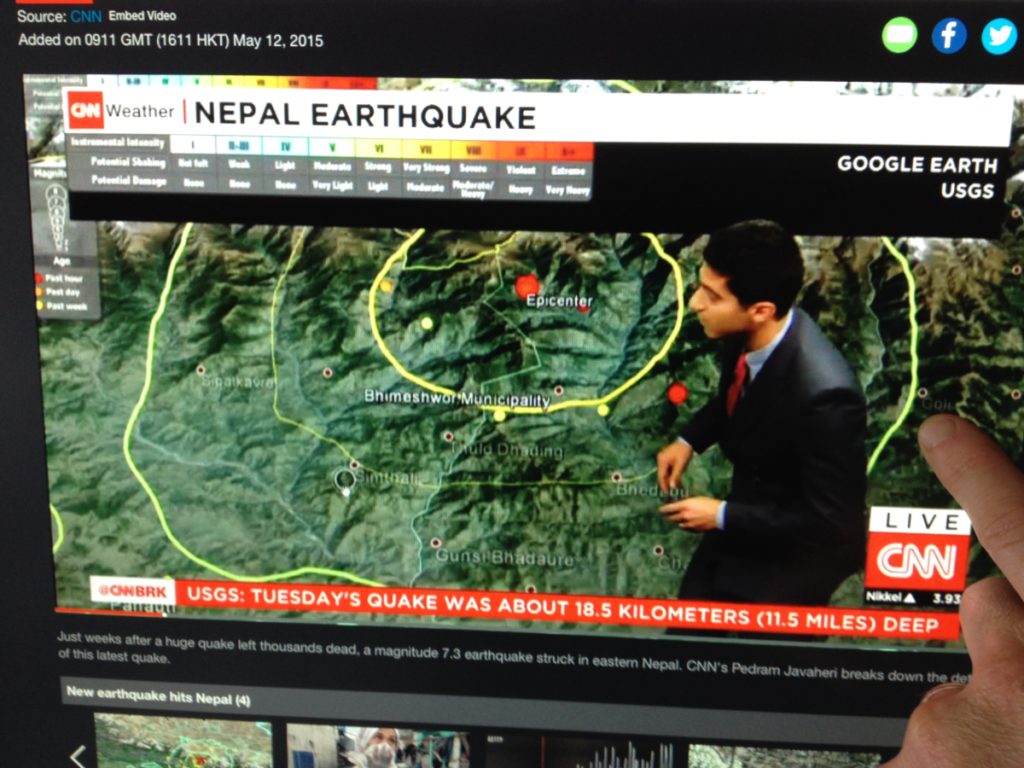
When the Earthquake Hit Kathmandu: A Moment I’ll Never Forget
I was sitting in the hotel lobby in Thamel around midday with Victor and Liza when Kathmandu suddenly started rocking. At first, the ground shifted gently—but within seconds, the entire hotel began to shake violently. We could barely stay on our feet. Struggling to move, we made our way toward an open area outside, but even there, standing upright was almost impossible.
For a brief moment, I genuinely thought it was the end. The sounds of buildings collapsing around us were deafening and terrifying. A hotel directly behind ours crumbled to the ground, tragically killing more than 60 people. The sheer horror of hearing walls cave in and screams echo from every direction is something that never leaves you.
Once the initial 7.8 magnitude earthquake shock wave passed, our focus shifted to survival and the safety of others. My thoughts immediately went to our trekking teams out in the mountains and friends scattered across different parts of Kathmandu.
A few of us ran to see if we could assist, but we were quickly reminded of the danger—aftershocks were still hitting, and buildings continued to fall. One collapsed in the very spot we had just been standing.
We retreated to a safer, open space. In that moment, with the city in chaos, we realized we were in no position to help without putting ourselves at further risk.
Searching for Our Team After the Kathmandu Earthquake
As the dust settled, our focus immediately shifted to locating friends and staff. Ronan and Magda had been out sightseeing and shopping in the streets of Kathmandu, and I hoped desperately they were safe and away from collapsing buildings. My thoughts were also with our local trekking staff and Sherpa friends, many of whom were scattered across the city and further afield in rural areas.
Remarkably, our hotel in Thamel had sustained very little damage, which gave us a temporary sense of relief. But the destruction just a few blocks away told a very different story. I eventually ventured out on foot in search of Dawa and his young son, Sonam. The streets were chaotic, littered with debris, and many of the surrounding buildings had completely collapsed. Each step felt risky as I carefully made my way over the rubble of fallen structures, fearing the next aftershock.
Leaving Thamel was difficult—roads were blocked, and access to many neighborhoods was impossible. Dawa’s home and our office were unreachable; the entrance was buried under debris. As I approached the area, I heard a man crying out in anguish.
His entire family had been inside their house when the earthquake struck. Tragically, their collapsed home now blocked the way to Dawa’s. Just then, I saw my friend Phurba Sherpa and Dawa’s cousin, Tendi. Phurba told me 18 people had been inside that building when it went down.
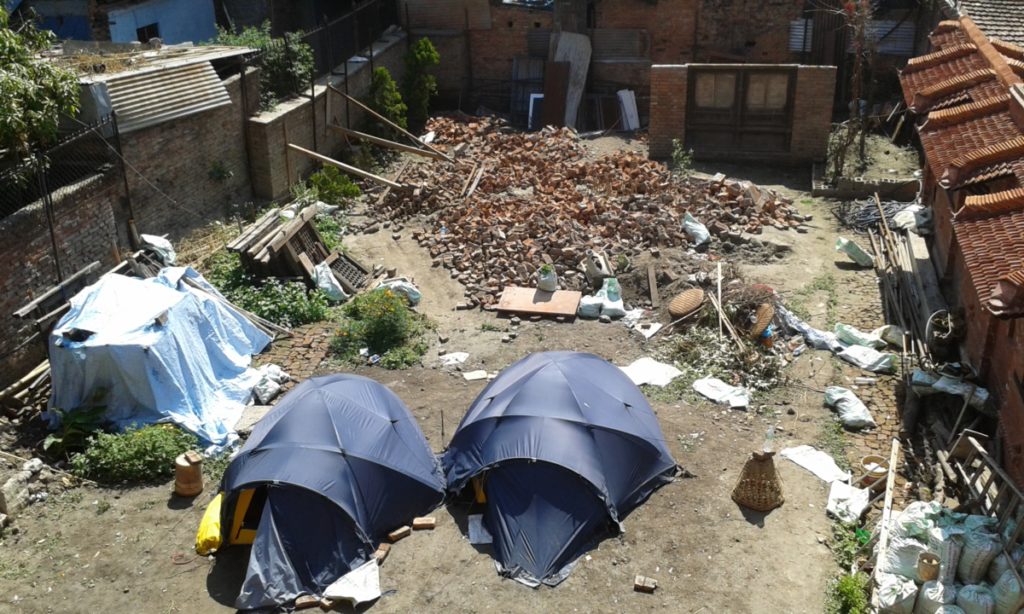
Searching for Dawa and Sonam Sherpa After the Earthquake
There was no sign of Dawa or his young son Sonam Sherpa anywhere in the area. I searched anxiously, hoping to spot them among the crowd. Just five minutes into looking, a powerful aftershock hit, sending hundreds of people running in panic through the narrow streets of Kathmandu. It was a terrifying reminder that the danger was far from over.
I continued walking around the neighborhood for nearly 45 minutes, stepping over rubble and damaged roads, calling out and hoping for a familiar face. With no luck and more aftershocks shaking the city, I decided to return to our hotel in Thamel. My next concern was making sure Ronan and Magda had made it back safely from sightseeing.
We waited in an open area near the hotel, one of the safest spots we could find. The tension was overwhelming until I finally received a call from Ronan—he and Magda were safe. Four hours after the initial earthquake, they returned to the hotel, visibly shaken but unharmed. To my immense relief, just an hour later, Dawa walked through the hotel doors. Seeing him again was an emotional moment I’ll never forget.
Life in Kathmandu After the Earthquake
That night, we were fortunate to have WiFi at the hotel, allowing me to speak with my wife and let her know we were safe, at least for now. Calls began coming in from newspapers in the UK and Ireland. Reporters wanted firsthand accounts of the Nepal earthquake and the destruction in Kathmandu.
I described the chaos I’d witnessed—the collapsed buildings, panicked crowds, and the uncertainty surrounding the emergency response. No one knew how quickly aid would arrive or what the next few days would bring.
The first four days following the 7.8 magnitude earthquake on April 25, 2015, were some of the most difficult. Kathmandu was in crisis. There was no clean water, no electricity, and food supplies were running low. The international airport was overwhelmed with people desperate to leave the country.
Aftershocks
I’ll never forget those haunting hours as the ground continued to shake with aftershocks, one after another. During this time, I was still focused on coordinating our team’s safe return. One of our groups was on Mera Peak, and getting updates from them was extremely difficult due to disrupted communication lines.
By Wednesday, April 29th, things started to stabilize—slightly. We still had no running water or electricity, but our clients had all returned safely to Kathmandu and were preparing for their journeys home. With logistics under control, Dawa and I turned our attention to helping where we could.
Over the next three days, we walked the streets of Thamel and surrounding areas, delivering aid and checking on communities in desperate need. What we witnessed was heartbreaking: bodies still lying in back alleys, families living in makeshift camps without access to water, food, or basic medical supplies.
The tourist district had transformed into a humanitarian crisis zone—and we did what we could to support the people we love and work alongside.
Heading Home After the Earthquake – But the Real Work Was Just Beginning
After dedicating all our time, resources, and money to immediate relief efforts in Kathmandu, it was finally time to think about going home. But my focus had already shifted—how could we support Dawa’s village and our trekking staff long-term? News had reached us that Dawa’s home village, Goli, located beneath Pikey Peak in the lower Everest region, had been devastated by the earthquake. Homes were flattened, and the remote mountain community was in ruins.
The Everest region of Nepal has given us so much over the years—countless memories, friendships, and a deep connection to the people and landscape. Now, it was our turn to give back in a meaningful way. In the years prior, we had already started supporting Goli village by sending energy-efficient stoves, but the destruction caused by the 2015 Nepal earthquake demanded a much larger response.
I’ll never forget that moment as my plane lifted off from Kathmandu at 9 p.m. on Friday, May 1st, 2015. It was a bittersweet farewell. The following morning, Dawa set out on a grueling 10-hour journey by bus to reach his village. With him, he carried tents, food, water, and essential supplies—not knowing exactly what he would find upon arrival. What he did know was this: the people of Goli needed help, and we would do everything in our power to be there for them.
Who We Support – Rebuilding Goli Village After the Earthquake
We’re still waiting for photos and videos to understand the full extent of the destruction in Goli village, but we know the damage is significant. While we haven’t heard from everyone yet, one thing is clear—now is the time to act. Our mission is to raise vital funds to support the people of Goli, a remote Himalayan village near Pikey Peak where so many kind, hardworking people call home.
This is a place that has given the trekking world some of its finest Sherpa guides. Now, it’s our turn to give something back. We’re launching a fundraising initiative to help provide food, shelter, and long-term support for the families affected by the 2015 Nepal earthquake.
Click here to learn more about Goli village and our Pikey Peak Support Trek — a unique way you can get involved, experience authentic Nepal, and directly contribute to rebuilding lives in this special community.
My personal earthquake experience in Kathmandu made one thing very clear: people in remote mountain regions are often the last to receive aid, but they need it the most. I believe it’s our responsibility to raise awareness and offer meaningful, lasting help to these incredible communities that have supported trekkers and climbers for decades.
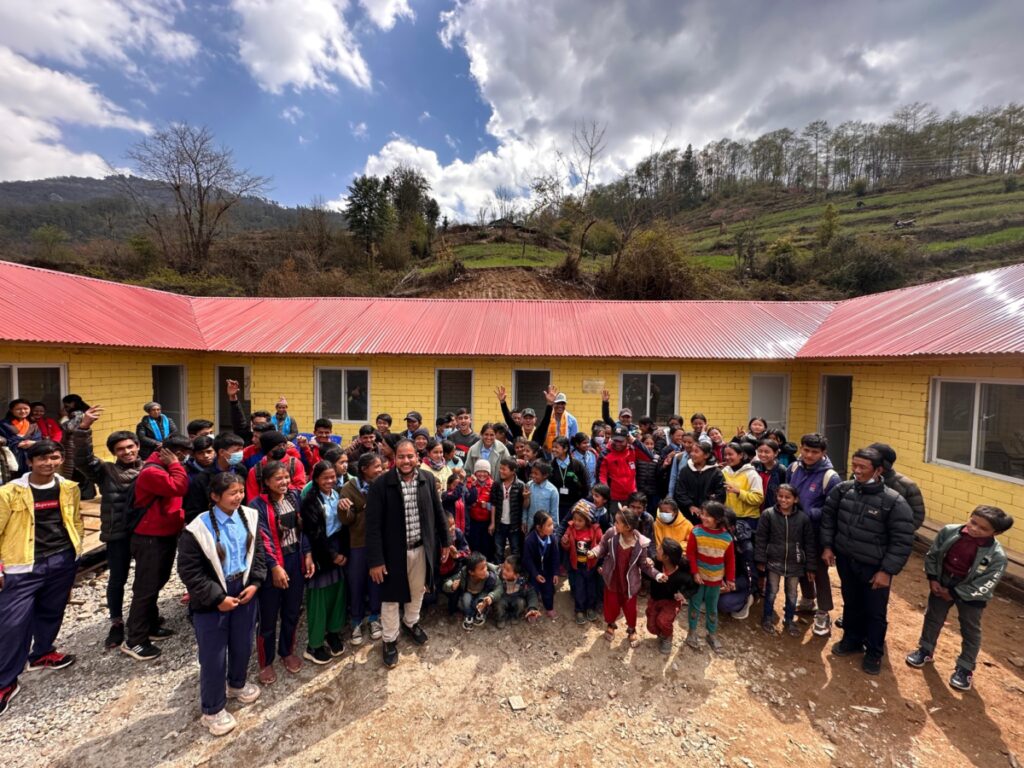
Four New Schools and Ongoing Support in Nepal
Since the devastating 2015 earthquake in Nepal, Ian Taylor Trekking has been committed to long-term recovery and community development in remote mountain villages. Thanks to the generosity of our supporters, we’ve not only rebuilt the damaged school in Goli village but also constructed four brand-new schools, giving hundreds of children access to safe, quality education in the Himalayas.
Our impact doesn’t stop there. We’ve installed over 200 energy-efficient stoves in local homes, improving health and reducing firewood use. Now, we’re taking the next step—raising funds to build a much-needed medical facility that will provide essential care to families living far from hospitals and clinics.
If you’re looking for a way to give back through ethical travel or are passionate about supporting sustainable development in Nepal, we invite you to join us. Whether you trek with us, donate, or help spread the word, you’ll be making a real difference in the lives of the people who’ve supported trekkers and climbers for generations.
Get involved today and help us build a brighter future for remote Himalayan communities.
